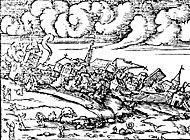Study pinpoints source of central Europe’s worst earthquake

Some 645 years after the worst earthquake in central European history, researchers have finally pinpointed its exact source in the forests and suburbs south of Basel. They have also predicted when the next major earthquake could strike the city.
The active fault, which continues to tremble, is marked at ground level by a ridge or escarpment. Researchers discovered that over the past 8,500 years, the fault has caused three successive ruptures, which have thrust the Earth’s surface up 1.8 metres.
The presence of nuclear and chemical industry in the area means that any seismic activity today could pose a serious threat to public safety. According to governmental and insurance estimates, an earthquake similar to the 1356 event would cause up to SFr80 billion worth of damage.
The study was conducted by the Federal Institute of Technology in Zurich, Basel University and Strasbourg University in France.
Earthquake scenario
“The minimum recurrence we have seen on the fault itself is three events over last 8,500 years,” said Domenico Giardini, professor of seismology at ETH Zurich and director of the Swiss Seismological Service. “So, the expected scenario for another earthquake is between 1,000 and 1,500 years.”
However, lead author of the study, Mustapha Meghraoui of Strasbourg University, warned that the pattern of seismic activity could only serve as a rough guide. “Earthquakes can be clustered in a certain period of time and some periods can be totally quiet,” he said.
Basel, which lies on the border near France and Germany, suffered catastrophic losses during the 1356 earthquake. Some 30 to 40 medieval castles collapsed in the hardest hit area and many more churches and towers toppled within a two hundred kilometre radius.
The earthquake was roughly comparable in magnitude to the disaster in Izmit in western Turkey, two years ago and reached an estimated magnitude of 6.5 on the Richter scale with intensities of IX to X.
Seismic activity
If there were a similar earthquake in Basel today, the experts believe that, on average, about four per cent of the buildings would collapse.
“If it happened today, the percentage of buildings which would actually fall would be in the order of a few per cent depending on the neighbourhood, depending on the local ground conditions and depending on the age of the buildings,” said Giardini.
Beginning near the Swiss Jura Mountains south of Basel, the fault scarp covers at least eight kilometres or nearly five miles. It extends in a northeasterly direction through a rift valley south of the Rhine river, traversing the flat fields of the Birs Valley to reach the city’s southern edge.
Finding the precise source of the 1356 Basel earthquake has been difficult because the fault is partly obscured by Alpine forests. In addition, seismic activity in the region is so infrequent that researchers could not determine the exact location.
To pinpoint the site, the scientists used a number of techniques including ground-penetrating radar.
The study is reported in the American journal, Science
by Vincent Landon

In compliance with the JTI standards
More: SWI swissinfo.ch certified by the Journalism Trust Initiative
You can find an overview of ongoing debates with our journalists here. Please join us!
If you want to start a conversation about a topic raised in this article or want to report factual errors, email us at english@swissinfo.ch.